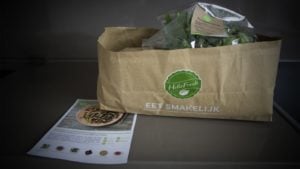
In the dynamic world of investing, meal kit delivery stocks have carved out a niche that’s hard to ignore. Offering the convenience of pre-portioned, ready-to-cook meals delivered right to your doorstep, these companies are redefining the food industry. Consequently, with lifestyles becoming increasingly fast-paced, the allure of such services is evident, making these stocks a potentially appetizing option for investors.
However, it’s vital to balance the scales. Positively, these companies serve the needs of health-focused, time-constrained consumers. Negatively, the sector faces stiff competition across a saturated market. Hence, this scenario prompts a vital inquiry. Are meal kit delivery stocks a sustainable investment or a transient phenomenon?
Furthermore, as we delve deeper, we’ll explore the factors that make these stocks an interesting investment choice, along with their potential risks. Significantly, market research firms like Statista, DataHorizzon Research, Global Market Insights, and Expert Market Research predict substantial sector growth. Further, global revenues are expected to surpass $17 billion in 2023. And, the U.S. market is projected to reach around $8.79 billion. Indeed, the meal kit delivery market is expanding rapidly.
Therefore, this analysis aims to unravel the intricacies and potentials of investing in this sector. Let’s dive into the fascinating world of meal kit delivery stocks for a comprehensive exploration.
HelloFresh SE (HLFFF)

HelloFresh (OTCMKTS:HLFFF), a prominent player in the meal kit delivery sector, has navigated a challenging year with resilience.
Despite a year-to-date (YTD) return showing a 30% loss, HelloFresh’s strategic moves underscore its adaptive business model. The company’s record-breaking average order value, announced in October, is a testament to its successful product enhancements. This milestone demonstrates HelloFresh’s commitment to elevating customer experience and value.
In August 2023, HelloFresh broadened its horizon with the launch of Factor, a ready-to-eat service, to the Netherlands and Flanders. This expansion into new service offerings reflects the company’s innovative approach to cater to evolving consumer preferences. HelloFresh’s financial performance in the first and third quarters of 2023 further highlights its growth trajectory.
In the first quarter, HelloFresh attained a record €2.02 billion in revenue, a 5% year-over-year (YOY) increase. This upward trend persisted into the third quarter, with revenue growing 4% to €1.80 billion compared to the same period last year.
In Q2 2023, HelloFresh achieved a record-high adjusted EBITDA of €192 million, marking a historic milestone for the company. A substantial increase in contribution margin and strong average order rates fueled this impressive figure.
Despite these successes, HelloFresh’s profit outlook for 2023 fell short of analysts’ expectations in March, primarily due to a dip in meal kit orders. However, the company’s dynamic strategy and financial resilience position it well for future growth in the competitive meal kit delivery landscape.
Uber Technologies (UBER)

Uber Technologies (NYSE:UBER), renowned for transforming ride-sharing, has impressively achieved a 115% YTD return.
This year, the company innovatively launched Uber Travel in the U.S. and is soon expanding to Canada. This service allows users to manage travel plans efficiently and offers a 10% rebate on booked rides.
Focusing on sustainability, Uber introduced Uber Comfort Electric in select cities. This move features luxury electric vehicles like Teslas and aligns with Uber’s ambitious 2040 zero-emission goal. Additionally, the company included an EV Hub and a charging map in its app, promoting EV adoption among drivers.
In the food delivery sector, Uber Eats has integrated voice-based ordering through Google Assistant globally, enhancing user convenience. Furthermore, Uber Eats partnered with Motional in Santa Monica, California. Together, they are piloting autonomous meal kit deliveries, initially with safety operators. Financially, Uber showed robust growth. Its revenue surged by 49% in the fourth quarter of 2022, reaching $8.61 billion. Rideshare revenue alone jumped by 82%, indicating a strong post-pandemic recovery.
Moreover, Uber piloted Uber Tasks in two U.S. cities. This innovative service allows hiring help for household tasks, offering new income opportunities for drivers. These strategic moves highlight Uber’s dedication to innovation, sustainability, and financial strength. Continuously adapting to market changes, Uber is exploring autonomous technology, particularly in meal kit delivery, to remain at the forefront of the transportation and delivery industries.
Walmart (WMT)

Walmart (NYSE:WMT), navigating through the dynamic retail landscape, has recently ventured into the meal kit delivery market. This strategic move is part of its broader initiative to offer convenient food solutions to its customers.
Despite facing a YTD return decrease of 8.1%, Walmart’s resilience is evident in its latest quarterly earnings. The company has impressively increased its net income to $453 million, a substantial growth of 125.2%, highlighting its strong financial performance.
Embracing consumer trends, Walmart has introduced meal kits priced between $8 and $15, catering to the growing demand for easy-to-prepare meals. This expansion, which includes a partnership with Gobble, is a reflection of Walmart’s commitment to diversifying its offerings and enhancing customer convenience. Available without a subscription, the meal kits underscore the company’s adaptability in a competitive market.
These initiatives, coupled with its strategic ventures like the meal kit service, position Walmart as a forward-thinking player in the retail sector. WMT can be adept at meeting evolving consumer needs while maintaining strong financial stability.
On the publication date, Faizan Farooque did not hold (directly or indirectly) any positions in the securities mentioned in this article. The opinions expressed in this article are those of the writer, subject to the InvestorPlace.com Publishing Guidelines.





